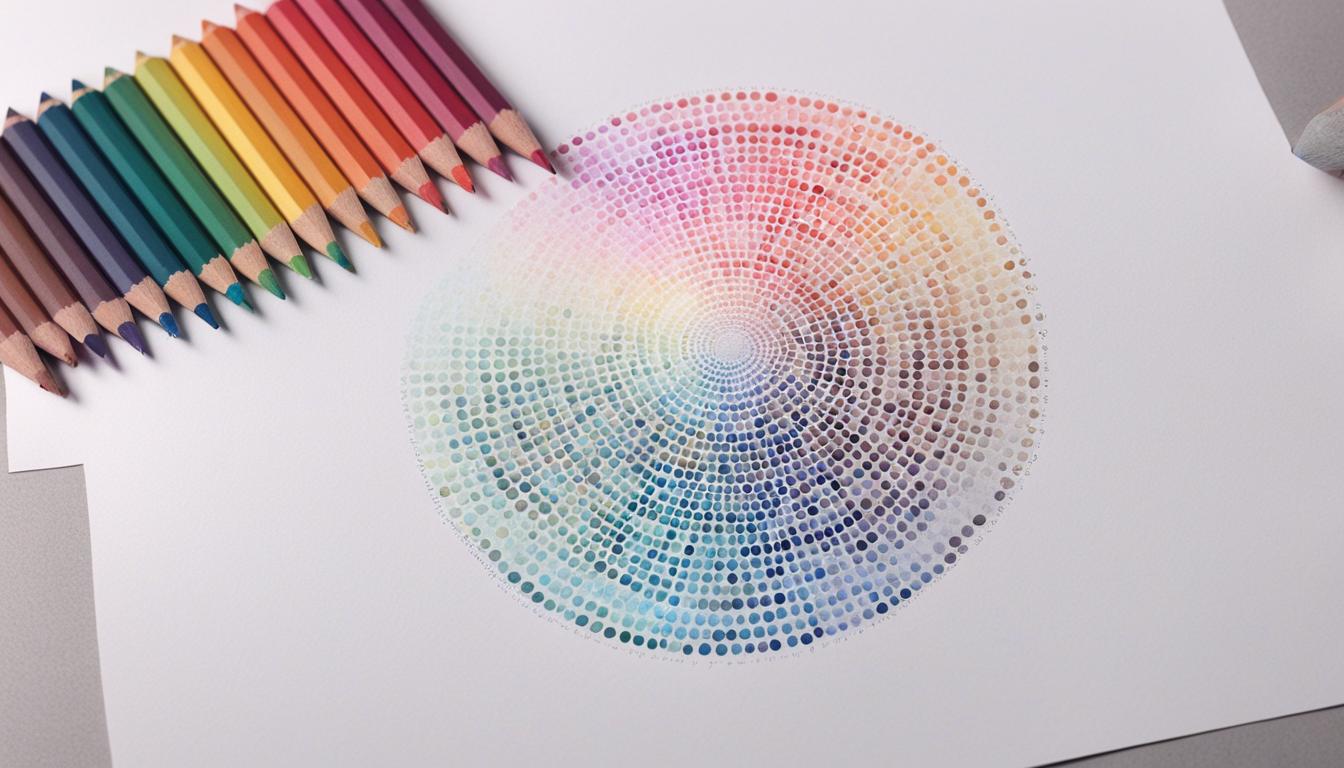
As a beginner in the world of art and coloring, it’s important to start with easy and basic coloring techniques that will lay a strong foundation for your skills. These techniques can help you create beautiful and vibrant artwork by adding texture, depth, and realism.
One of the most important techniques to master is cross hatching. This technique involves drawing a series of parallel lines and layering another set of lines in a different direction on top. Cross hatching can add texture to your artwork and is a great starting point for beginners.
Another technique to explore is pressure shading. By varying the pressure you apply with your colored pencil, you can create shading and depth in your artwork. This technique is versatile and can be used with different coloring mediums, such as colored pencils and markers.
Blending multiple colors is another essential technique for beginners. Layering different colors on top of each other creates smooth and seamless transitions. Experiment with colored pencils or markers to create unique color blends and gradients.
By mastering these techniques and practicing regularly, you’ll be able to create stunning artwork and bring your imagination to life. Remember, as a beginner, it’s important to start with simple techniques and gradually build upon your skills.
Key Takeaways:
- Start with easy and basic coloring techniques as a beginner.
- Master cross hatching to add texture to your artwork.
- Practice pressure shading to create shading and depth.
- Experiment with blending multiple colors for seamless transitions.
- Regular practice is crucial for improving your coloring skills.
Cross Hatching
Cross hatching is a coloring technique that involves drawing a series of parallel lines and then adding another series of parallel lines in a different direction on top of the first set of lines. This technique can create texture and shading in your artwork.
While cross hatching is quick and easy to do, it may result in a flat appearance and is not ideal for creating depth or adding multiple colors. It is important to practice cross hatching to achieve even and consistent lines.
One of the key advantages of cross hatching is its ability to add dimension and texture to your drawings. By varying the spacing between the lines and their direction, you can create different effects and patterns. This technique is commonly used in architectural renderings, comic book illustrations, and shading realistic objects.
To get started with cross hatching, follow these steps:
- Choose your subject: Select an object or scene that you want to draw and determine the areas where you want to add shading or create texture.
- Decide on the direction of your lines: Consider the form and shape of the subject and decide on the direction in which your lines will be drawn. This can be vertical, horizontal, diagonal, or a combination of directions.
- Start with light pressure: Begin by lightly drawing parallel lines in one direction. These lines should be equidistant from each other and evenly spaced.
- Add the second set of lines: Once you have drawn the first set of lines, add another set of lines in a different direction. These lines should intersect with the first set, creating a cross hatch pattern.
- Vary the spacing and direction: To create different effects, vary the spacing between the lines and their direction. Closer lines will create darker shading, while wider spacing will create lighter shading.
- Practice and experiment: Cross hatching is a technique that improves with practice. Experiment with different subjects, line widths, and line directions to develop your own unique style.
Remember to have fun and enjoy the process of learning and exploring the cross hatching technique. With time and practice, you’ll be able to create stunning drawings with depth and texture.
Pressure Shading
Pressure shading is a versatile coloring technique that adds depth and dimension to your artwork. By applying different levels of pressure with your colored pencil, you can effortlessly create lighter or darker shades, giving your drawings a three-dimensional effect.
To master the art of pressure shading, it is essential to understand how much pressure to apply. Experiment with varying levels of pressure to achieve the desired shade intensity. Lighter pressure will result in a lighter shade, while applying more pressure will produce a darker shade.
One of the advantages of pressure shading is that it can be used with different coloring mediums, such as colored pencils and markers. This technique allows you to seamlessly blend and transition between shades, creating smooth and gradual color gradients.
Here are some tips to help you practice pressure shading effectively:
- Start with a light touch and gradually increase the pressure as needed.
- Hold the colored pencil firmly but comfortably, giving you better control over the pressure applied.
- Experiment with different pencil angles to achieve varying line thickness and shading effects.
- Use small circular motions or back-and-forth strokes to evenly distribute the color and create a smooth appearance.
- Take your time and be patient. Developing your pressure shading skills takes practice, so don’t be discouraged if it doesn’t come naturally at first.
Remember, the key to successful pressure shading is to practice regularly and allow yourself room for experimentation. With time and experience, you will gain confidence in using this technique to enhance your artwork.

Benefits of Pressure Shading
Pressure shading offers several benefits to aspiring artists:
- Enhanced Realism: By creating depth and shading, pressure shading gives your artwork a more realistic and lifelike appearance.
- Improved Dimension: The technique allows you to add volume and dimension to your drawings, making them visually appealing and interesting.
- Seamless Blending: Pressure shading enables you to seamlessly blend colors, resulting in smooth and natural transitions between shades.
- Versatility: Whether you prefer colored pencils or markers, pressure shading can be utilized across different mediums, providing you with greater flexibility in your artistic endeavors.
As you continue to develop your pressure shading skills, remember to practice in combination with other coloring techniques to achieve stunning results. With perseverance and dedication, you’ll soon master the art of pressure shading and bring your artwork to life.
Blending Multiple Colors
Blending multiple colors is a crucial technique in the world of coloring. It allows you to create smooth and seamless transitions between different shades, adding depth and dimension to your artwork. Whether you’re using colored pencils or markers, mastering the art of color blending can take your coloring skills to the next level.
When using colored pencils, the secret to successful blending lies in layering. Start by applying one color to your paper, and then gently layer another color on top of it. Use small circular motions or back-and-forth strokes to blend the colors together. Repeat this process with additional colors, gradually building up the desired effect.
If you prefer using markers, blending colors is just as achievable. You can blend colors by overlapping them on the paper or by using a colorless blender pen. The combination of different hues will blend smoothly to create beautiful gradients and transitions.
To truly master the art of blending multiple colors, it’s essential to experiment with a variety of color combinations. Explore different palettes and see how various colors interact with one another. By practicing and refining your color blending techniques, you’ll gain a better understanding of how to use colors effectively to achieve your desired results.
“Color blending allows artists to create stunning visual effects by seamlessly merging different hues and tones together.”
Conclusion
Mastering coloring techniques is an essential part of developing your artistic skills. As a beginner, it is crucial to start with basic techniques and gradually progress to more advanced ones. The key techniques to focus on include cross hatching, pressure shading, blending multiple colors, burnishing, and blending with solvents. By practicing these techniques, you can enhance your artwork with texture, depth, and vibrant colors.
Colored pencils prove to be a popular medium for coloring due to their versatility and ease of use. Pay attention to holding the pencil correctly, hiding pencil strokes, and understanding the tooth of the paper to achieve optimal results. Regular practice and experimentation with different techniques and color combinations will elevate your artistic skills even further.
When it comes to coloring, remember to have fun and enjoy the process. The key takeaways from these coloring techniques include the importance of starting with basic techniques, gradually incorporating more complex ones, and practicing regularly. With dedication and creativity, you will be able to create stunning artworks that showcase your newfound coloring expertise.
FAQ
What are coloring techniques?
Coloring techniques are specific skills that can enhance your artwork by adding texture, depth, and realism.
What are some important coloring techniques for beginners?
Some important coloring techniques for beginners include cross hatching, pressure shading, blending multiple colors, burnishing, and blending with solvents.
Which coloring medium is popular for beginners?
Colored pencils are a popular medium for coloring.
How can cross hatching enhance my artwork?
Cross hatching can create texture and shading in your artwork, but it may result in a flat appearance and is not ideal for creating depth or adding multiple colors.
What is pressure shading?
Pressure shading involves applying different levels of pressure to create shading and depth in your artwork.
How can I blend multiple colors?
To blend colors with colored pencils, start by applying one color and then gently layering another color on top, using small circular motions or back-and-forth strokes. With markers, you can blend colors by overlapping them or using a colorless blender pen.
